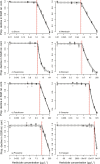Toxicity of ten herbicides to the tropical marine microalgae Rhodomonas salina
- PMID: 32376837
- PMCID: PMC7203118
- DOI: 10.1038/s41598-020-64116-y
Toxicity of ten herbicides to the tropical marine microalgae Rhodomonas salina
Abstract
Herbicide contamination of nearshore tropical marine ecosystems is widespread and persistent; however, risks posed by most 'alternative' herbicides to tropical marine microalgae remain poorly understood. Experimental exposures of the important but understudied microalgae Rhodomonas salina to seven individual Photosystem II (PSII) inhibitor herbicides (diuron, metribuzin, hexazinone, tebuthiuron, bromacil, simazine, propazine) led to inhibition of effective quantum yield (ΔF/Fm') and subsequent reductions in specific growth rates (SGR). The concentrations which reduced ΔF/Fm' by 50% (EC50) ranged from 1.71-59.2 µg L-1, while the EC50s for SGR were 4-times higher, ranging from 6.27-188 µg L-1. Inhibition of ΔF/Fm' indicated reduced photosynthetic capacity, and this correlated linearly with reduced SGR (R2 = 0.89), supporting the application of ∆F/Fm' inhibition as a robust and sensitive indicator of sub-lethal toxicity of PSII inhibitors for this microalga. The three non-PSII inhibitor herbicides (imazapic, haloxyfop and 2,4-Dichlorophenoxyacetic acid (2,4-D)) caused low or no toxic responses to the function of the PSII or growth at the highest concentrations tested suggesting these herbicides pose little risk to R. salina. This study highlights the suitability of including R. salina in future species sensitivity distributions (SSDs) to support water quality guideline development for the management of herbicide contamination in tropical marine ecosystems.
Conflict of interest statement
The authors declare no competing interests.
Figures




Similar articles
-
Toxicity of the herbicides diuron, propazine, tebuthiuron, and haloxyfop to the diatom Chaetoceros muelleri.Sci Rep. 2020 Nov 11;10(1):19592. doi: 10.1038/s41598-020-76363-0. Sci Rep. 2020. PMID: 33177549 Free PMC article.
-
Toxicity thresholds of nine herbicides to coral symbionts (Symbiodiniaceae).Sci Rep. 2021 Nov 4;11(1):21636. doi: 10.1038/s41598-021-00921-3. Sci Rep. 2021. PMID: 34737333 Free PMC article.
-
Phytotoxicity of four photosystem II herbicides to tropical seagrasses.PLoS One. 2013 Sep 30;8(9):e75798. doi: 10.1371/journal.pone.0075798. eCollection 2013. PLoS One. 2013. PMID: 24098726 Free PMC article.
-
Herbicide Exposure and Toxicity to Aquatic Primary Producers.Rev Environ Contam Toxicol. 2020;250:119-171. doi: 10.1007/398_2020_48. Rev Environ Contam Toxicol. 2020. PMID: 32945954 Review.
-
The ecotoxicological effects of Photosystem II herbicides on corals.Mar Pollut Bull. 2005;51(5-7):495-506. doi: 10.1016/j.marpolbul.2005.06.027. Epub 2005 Jul 27. Mar Pollut Bull. 2005. PMID: 16054161 Review.
Cited by
-
Toxicity thresholds of three insecticides and two fungicides to larvae of the coral Acropora tenuis.PeerJ. 2020 Jul 28;8:e9615. doi: 10.7717/peerj.9615. eCollection 2020. PeerJ. 2020. PMID: 33194337 Free PMC article.
-
Toxicity of herbicides to the marine microalgae Tisochrysis lutea and Tetraselmis sp.Sci Rep. 2024 Jan 19;14(1):1727. doi: 10.1038/s41598-024-51401-3. Sci Rep. 2024. PMID: 38242962 Free PMC article.
-
High-throughput profiling of metabolic responses to exogenous nutrients in Synechocystis sp. PCC 6803.mSystems. 2024 Apr 16;9(4):e0022724. doi: 10.1128/msystems.00227-24. Epub 2024 Mar 27. mSystems. 2024. PMID: 38534128 Free PMC article.
-
Emerging Strategies for the Bioremediation of the Phenylurea Herbicide Diuron.Front Microbiol. 2021 Aug 12;12:686509. doi: 10.3389/fmicb.2021.686509. eCollection 2021. Front Microbiol. 2021. PMID: 34475856 Free PMC article. Review.
-
The use of integrative tools and multiple models for aquatic environmental quality assessment: a case study of the Mirim Lagoon, Southern Brazil.Environ Monit Assess. 2024 Jan 25;196(2):200. doi: 10.1007/s10661-024-12336-4. Environ Monit Assess. 2024. PMID: 38270819
References
-
- Basheer C, Obbard JP, Lee HK. Persistent organic pollutants in Singapore’s coastal marine environment: part I, seawater. Water, Air, Soil Pollut. 2003;149:295–313. doi: 10.1023/A:1025689600993. - DOI
-
- Roche, H., Salvat, B. & Ramade, F. Assessment of the pesticides pollution of coral reefs communities from French Polynesia. Rev. Ecol. (2011).
Publication types
MeSH terms
Substances
LinkOut - more resources
Full Text Sources

